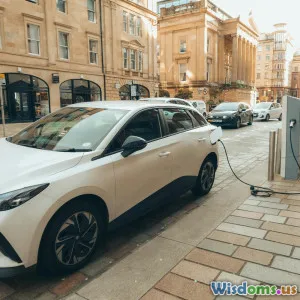
Hybrid vs Electric Which Saves More Money Over Five Years
11 min read Explore which saves you more money over five years: hybrid or electric cars, analyzing costs, savings, and real-world impacts. (0 Reviews)
Hybrid vs Electric: Which Saves More Money Over Five Years?
The future of personal transportation is undeniably electric. As automakers race to electrify their fleets, consumers are increasingly faced with a tough choice: should they invest in a hybrid or go fully electric? Beyond environmental benefits, one of the biggest questions on the minds of car buyers is financial—which vehicle truly offers greater savings over a five-year ownership period? Let’s dive deep into the costs, savings, and nuances that differentiate hybrids from electric vehicles (EVs) and uncover which option makes the most fiscal sense.
Introduction
Hybrid and electric cars have fast gained popularity, each promising unique advantages. Hybrids combine an internal combustion engine with an electric motor, offering improved fuel efficiency and lower emissions without sacrificing traditional range. EVs, by contrast, rely solely on electric power, eliminating gasoline consumption altogether.
With advancements in battery technology, changing fuel prices, and evolving government incentives, the financial dynamics between these two options have shifted. This article dissects major cost factors—purchase price, fuel savings, maintenance, and incentives—to provide an informed comparison over a common timeframe of five years.
Understanding the Cost Factors
Before concluding which option saves more, it’s essential to understand the underlying components of ownership cost.
1. Purchase Price
Typically, hybrids have a lower sticker price than full EVs due to less complex battery packs and the inclusion of a gasoline engine which is cheaper to produce at scale currently.
For instance, the 2024 Toyota Prius Hybrid starts around $27,000, whereas the 2024 Nissan Leaf EV begins at about $28,000, and the Tesla Model 3 Standard Range starts closer to $40,000. While prices can vary, EVs often carry a premium for advanced batteries and electric drive systems.
2. Fuel and Energy Costs
Hybrids offer improved mileage compared to traditional gasoline cars, but still rely on fuel. The Toyota Prius, for example, delivers about 56 MPG combined, whereas an EV’s “fuel”—electricity—typically costs less per mile.
According to the U.S. Department of Energy, the average cost to drive 100 miles in an EV is around $4.00 compared to $9.00 for a gasoline vehicle consuming 25 MPG at $3.00 per gallon. Hybrids lie somewhat in between.
3. Maintenance and Repairs
Electric vehicles enjoy reduced maintenance because they have fewer moving parts—no oil changes, fewer brake replacements thanks to regenerative braking, and no complex exhaust systems. EV owners typically save about $300 to $500 per year on maintenance compared to ICE vehicles.
Hybrids, using both gasoline and electric propulsion, have more complex systems which can increment maintenance costs slightly but still less than pure ICE vehicles.
4. Government Incentives
Many countries and states encourage adoption of greener vehicles through rebates, tax credits, or reduced registration fees, often favoring full EVs. For example, in the U.S., some buyers can claim up to $7,500 federal tax credit for EVs, whereas hybrids often get less or no credit.
These incentives can significantly influence the total cost of ownership.
Breaking Down the Numbers Over Five Years
Now, let’s explore a comparative cost scenario over five years using real-world data.
| Cost Factor | Toyota Prius Hybrid | Nissan Leaf EV | Tesla Model 3 EV |
|---|---|---|---|
| Purchase Price | $27,000 | $28,000 | $40,000 |
| Federal Tax Credit | $0 | -$7,500 | -$7,500 (eligible) |
| Net Price After Credit | $27,000 | $20,500 | $32,500 |
| Fuel/Electric Costs | ~$5,000 ($2.75/gal) | ~$1,500 ($0.13/kWh) | ~$1,500 ($0.13/kWh) |
| Maintenance Costs | $4,000 | $2,000 | $2,000 |
| Depreciation (Est.) | $10,000 | $12,000 | $16,000 |
| Total 5-Year Cost | $46,000 | $36,000 | $52,000 |
Key Insights:
- The Nissan Leaf, an affordable EV, offers substantial savings mainly due to lower running and maintenance costs aided by tax credits.
- The Prius Hybrid has a relatively lower upfront price but incurs higher fuel and maintenance expenses.
- Tesla Model 3, while an EV, has a premium price and higher depreciation, increasing overall cost despite fuel and maintenance savings.
The Role of Usage Patterns
Who wins in cost savings often depends heavily on how the vehicle is used.
Urban Commuters: Those driving mostly city miles with frequent stops benefit from EVs and hybrids due to regenerative braking and electric motor efficiency. EV charging at home can further reduce cost per mile.
Long-Distance Drivers: Hybrids can shine here as they don’t rely on charging infrastructure and avoid range anxiety. A Prius can easily fuel up anywhere without extra time, possibly making it more convenient and economical if electricity costs are high or chargers scarce.
Availability of Charging: EV savings increase when owners have access to affordable, home or workplace charging; otherwise, public charging fees and inconvenience may reduce savings.
Real-World Perspectives
As articulated by automotive analyst James Bell via Forbes: “For many consumers, the decision between hybrid and electric isn’t only about price — it’s about lifestyle and geography.” He highlights that while electric vehicles present clear savings in fuel and maintenance, they require a change in refueling habits that not all might be ready or able to make.
Consumer reports corroborate that hybrids often present a balanced, less disruptive transition to electrification, especially in rural areas.
Conclusion: Which Saves More Money Over Five Years?
Evaluating purchase price, operating costs, maintenance, incentives, and personal usage patterns, fully electric vehicles generally save more money over five years, especially with government incentives and accessible charging infrastructure.
Affordable EV models like the Nissan Leaf or Chevy Bolt lead the pack with lower total ownership costs compared to hybrids such as the Toyota Prius. However, the higher-end EVs with significant depreciation can narrow these savings.
Hybrids offer a compelling middle ground early in the adoption curve—cheaper upfront, with decent savings on fuel and maintenance. For areas lacking sufficient charging infrastructure or drivers with very high mileage and long trips, hybrids may be preferable.
In summary:
- If you have access to reliable and affordable electric charging and can take advantage of incentives, an EV likely saves more money over five years.
- If upfront cost and convenience are your priorities, especially in less EV-friendly environments, hybrids may be better.
The bottom line is to analyze your specific driving profile, available incentives, and local fuel/electricity costs to make the smartest economic decision.
By carefully balancing these factors, you can enjoy the benefits of electrified driving while optimizing savings.
Sources:
- U.S. Department of Energy, Alternative Fuels Data Center
- Consumer Reports (2023)
- Kelley Blue Book
- Forbes (James Bell articles on EV vs Hybrid)
Rate the Post
User Reviews
Other posts in Hybrid Cars
Popular Posts















